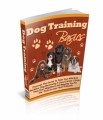Salespage Snapshot:

Table Of Contents
Foreword
Chapter 1: Training Basics
Chapter 2: What Equipment Do You Need
Chapter 3: Start With Easy Commands
Chapter 4: Moving On To More Advanced Commands
Chapter 5: House Training
Chapter 6: Make Sure To Use Rewards And Not Punishment
Chapter 7: The Trouble With Not Training Your Dog
Wrapping Up
Sample Content Preview
Chapter 2: What Equipment Do You Need
Synopsis
Before deciding on what equipment to use to train the dog, the owner must first identify the purpose of the training and the end goal desired. There are a lot of issues that contribute to a training session and having a clear goal in mind will help both the dog and the owner to work together to achieve the goal.
What You Will Need
There is also the need to identify the type of training that will be required based on the goal set. If the training is only to create some boundaries for the dog, then the owner will be able to indentify a less vigorous training style to use to achieve the objective, with the least amount of heartache on both sides. The equipment needed will also be very basic, such as a dog leash, a dog collar and perhaps some tasty treats.
However if the training is going to be for more focused goals such as to create a championship show dog or a seeing eye dog, then the equipment needed will be considerably different and definitely more custom made to these goals. The more complex the goal, the more focused the training equipment will be. These types of equipment will usually have to be sourced from specialty shops that are well equipped to provide a variety of specifically designed items for dog training. The local pet shops will usually not carry such custom made equipment, thus there is a need to know what is needed before the actual sourcing process begins.
The owner should also be well versed in how to use the equipment purchased and understand its relevant purposes. Failing to do this very important task will not help in the actual training exercise as the dog will only end up being confused and frustrated when the commands given vary too much and the equipment used does not correspond with it.
Chapter 3: Start With Easy Commands
Synopsis
Teaching a dog to respond to certain commands in a very specific way requires communicating with the animal on a level that can easily be understood. The dog’s response to the commands will indicate the understanding of the command given and if the desired outcome is evident then the command is considered understood. Therefore, the owner should ideally take the time of identify a few simple commands and put them into practice in a simple and nonthreatening way.
Start Small
The following are some of the more popular commands that most dogs can relate to:
• Come – this is probably the most important command that should be taught to the animal as soon as possible. This is important in portraying to the dog, who is in control, and training the dog until an immediate response is received to the command will be needed.
• Sit – this is another command that is popularly taught to the dog as it enables the owner to get the dog to focus and be still. Whenever the dog gets too excitable, this command is usually issued to quite the animal and create a sense of calm. This command is also used when there is a need to stop the dog from moving around and is especially useful for meal times. Training the dog to sit and wait to be served its meal is a popular reason for this command.
• Stay – this command is usually given when there is a need to immobilize the dog immediately with any physical intervention. It is usually issued to keep the dog from causing a stir or becoming a nuisance to others around. However, this is not really an easy command to get the dog to participate in as dogs are generally very curious and friendly animals and restraining them can be a task.
Chapter 4: Moving On To More Advanced Commands
Synopsis
Once a dog has successfully learned all the basic commands, there may be an interest on the part of the owner to venture further into some advanced commands for the dog. These more advanced commands may be an extension of the present basic ones or something totally new. However, in most cases they are just an extension of commands already well versed for both dog and owner.
The Harder Stuff
Training the place command is perhaps the next step because it is a follow up to the sit command. This is a command where the dog actually stops at a specific point next to the owner and awaits further instructions. This can be further extended by getting the dog to make circular motions around the owner in the quest to be showier to onlookers.
Another popular command that is considered more advanced is the sit and stay command. This teaches the dog to stay in one place, even when the owner moves away. If the dog instinctively follows which is always the norm, the owner then has to get the dog to understand that they are required to remain in the designated place. Directing the dog back to the position intended every time it moves will eventually create the understanding of what is required, thus making a successful command fruitful.
Teaching the dog to remain in one place for long periods of time is also another advanced command that can be rather useful. This is especially so, if the owner needs to go into shops or cafes where pets are not allowed. Being able to get the dog to sit quietly in spite of the distractions that may arise, while the owner is inside will be well worth the effort. Once the dog understands the owners commands this actions will be easily achieved.
Other Details- 1 Article (DOC)
- 1 Ebook (DOCX, PDF), 19 Pages
- 1 Lead Magnet Report (DOC, PDF), 10 Pages
- 1 Autoresponder Email Messages (TXT)
- 1 Salespage (HTML)
- Ecover (JPG)
- File Size: 15,136 KB













